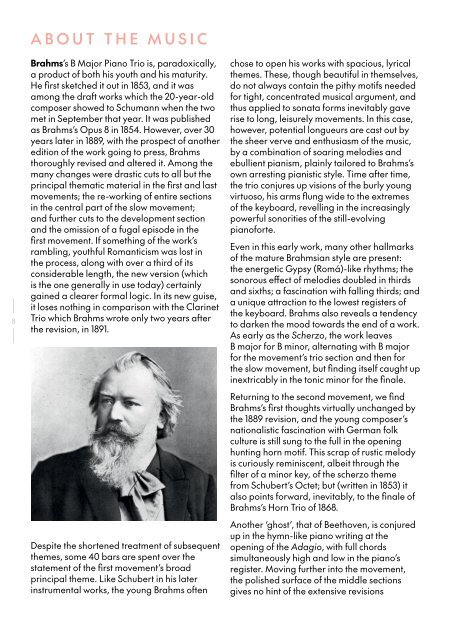Z.E.N. Trio Program Guide | August 2022
You also want an ePaper? Increase the reach of your titles
YUMPU automatically turns print PDFs into web optimized ePapers that Google loves.
|<br />
8<br />
|<br />
ABOUT THE MUSIC<br />
Brahms’s B Major Piano <strong>Trio</strong> is, paradoxically,<br />
a product of both his youth and his maturity.<br />
He first sketched it out in 1853, and it was<br />
among the draft works which the 20-year-old<br />
composer showed to Schumann when the two<br />
met in September that year. It was published<br />
as Brahms’s Opus 8 in 1854. However, over 30<br />
years later in 1889, with the prospect of another<br />
edition of the work going to press, Brahms<br />
thoroughly revised and altered it. Among the<br />
many changes were drastic cuts to all but the<br />
principal thematic material in the first and last<br />
movements; the re-working of entire sections<br />
in the central part of the slow movement;<br />
and further cuts to the development section<br />
and the omission of a fugal episode in the<br />
first movement. If something of the work’s<br />
rambling, youthful Romanticism was lost in<br />
the process, along with over a third of its<br />
considerable length, the new version (which<br />
is the one generally in use today) certainly<br />
gained a clearer formal logic. In its new guise,<br />
it loses nothing in comparison with the Clarinet<br />
<strong>Trio</strong> which Brahms wrote only two years after<br />
the revision, in 1891.<br />
Despite the shortened treatment of subsequent<br />
themes, some 40 bars are spent over the<br />
statement of the first movement’s broad<br />
principal theme. Like Schubert in his later<br />
instrumental works, the young Brahms often<br />
chose to open his works with spacious, lyrical<br />
themes. These, though beautiful in themselves,<br />
do not always contain the pithy motifs needed<br />
for tight, concentrated musical argument, and<br />
thus applied to sonata forms inevitably gave<br />
rise to long, leisurely movements. In this case,<br />
however, potential longueurs are cast out by<br />
the sheer verve and enthusiasm of the music,<br />
by a combination of soaring melodies and<br />
ebullient pianism, plainly tailored to Brahms’s<br />
own arresting pianistic style. Time after time,<br />
the trio conjures up visions of the burly young<br />
virtuoso, his arms flung wide to the extremes<br />
of the keyboard, revelling in the increasingly<br />
powerful sonorities of the still-evolving<br />
pianoforte.<br />
Even in this early work, many other hallmarks<br />
of the mature Brahmsian style are present:<br />
the energetic Gypsy (Romá)-like rhythms; the<br />
sonorous effect of melodies doubled in thirds<br />
and sixths; a fascination with falling thirds; and<br />
a unique attraction to the lowest registers of<br />
the keyboard. Brahms also reveals a tendency<br />
to darken the mood towards the end of a work.<br />
As early as the Scherzo, the work leaves<br />
B major for B minor, alternating with B major<br />
for the movement’s trio section and then for<br />
the slow movement, but finding itself caught up<br />
inextricably in the tonic minor for the finale.<br />
Returning to the second movement, we find<br />
Brahms’s first thoughts virtually unchanged by<br />
the 1889 revision, and the young composer’s<br />
nationalistic fascination with German folk<br />
culture is still sung to the full in the opening<br />
hunting horn motif. This scrap of rustic melody<br />
is curiously reminiscent, albeit through the<br />
filter of a minor key, of the scherzo theme<br />
from Schubert’s Octet; but (written in 1853) it<br />
also points forward, inevitably, to the finale of<br />
Brahms’s Horn <strong>Trio</strong> of 1868.<br />
Another ‘ghost’, that of Beethoven, is conjured<br />
up in the hymn-like piano writing at the<br />
opening of the Adagio, with full chords<br />
simultaneously high and low in the piano’s<br />
register. Moving further into the movement,<br />
the polished surface of the middle sections<br />
gives no hint of the extensive revisions


















